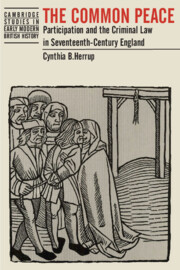Book contents
- Frontmatter
- Contents
- List of figures and tables
- Acknowledgments
- Glossary
- Abbreviations and conventions
- 1 The criminal law in early modern England
- 2 The setting
- 3 Judicial power and cooperation in eastern Sussex
- 4 From crime to criminal accusation
- 5 From accusation to indictment
- 6 From indictment to conviction
- 7 Becoming a criminal
- 8 The common peace
- Appendix 1 Summary of sampled courts
- Appendix 2 Status categories
- Bibliography
- Index
- Cambridge Studies in Early Modern British History
Appendix 2 - Status categories
Published online by Cambridge University Press: 10 January 2011
- Frontmatter
- Contents
- List of figures and tables
- Acknowledgments
- Glossary
- Abbreviations and conventions
- 1 The criminal law in early modern England
- 2 The setting
- 3 Judicial power and cooperation in eastern Sussex
- 4 From crime to criminal accusation
- 5 From accusation to indictment
- 6 From indictment to conviction
- 7 Becoming a criminal
- 8 The common peace
- Appendix 1 Summary of sampled courts
- Appendix 2 Status categories
- Bibliography
- Index
- Cambridge Studies in Early Modern British History
Summary
In general, the categorizations shown below follow those laid out by R. H. and A. J. Tawney in their essay on seventeenth-century occupations. But it must be remembered that the only constant in the social structure of early modern England seems to be its rich local variation over both time and space. These categories would be most useful as part of a statistical description of the social structure of individual communities in eastern Sussex, but such a project is fraught with difficulties. No contemporary local analysis tying status to population exists, and modern analyses favor the more concrete categories of income or tenurial status to the vaguer labels of social position. The accuracy as well as the local applicability of contemporary national descriptions are, as a result, questionable.
Another book would be necessary to delve fully into the complexities of the social structure in eastern Sussex; all that can be attempted here is a summary of some of the information most pertinent to legal administration. Population density in the region varied widely, with the least populous parishes in the Downs and the densest concentrations of people in the Weald. The eighty-one parishes for which the ecclesiastical returns of 1603 survive show adult communicants ranging per parish from eight (at East Aldrington, in the Downs) to six hundred (at Heathfield, in the Weald).
- Type
- Chapter
- Information
- The Common PeaceParticipation and the Criminal Law in Seventeenth-Century England, pp. 208 - 211Publisher: Cambridge University PressPrint publication year: 1987



